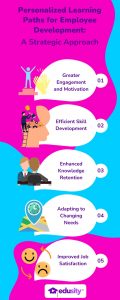Successful organizations are constantly seeking innovative ways to foster employee growth and development. Traditional, one-size-fits-all training programs no longer meet the evolving demands of your workforce. Instead, personalized learning paths that recognize all learners are individuals help address employee needs and learning styles. This strategic approach has gained significant traction, yielding many benefits for employees and the organizations that embrace it.
Read on to discover the many benefits of tailoring training programs to individual employee needs and learning styles, the role of data analytics and employee assessments in identifying skill gaps, and the success stories of organizations that have reaped the benefits of personalized learning paths for employee development.
These are the five main advantages of adopting programs with personalized learning paths.

-
Greater Engagement and Motivation
Employees are more likely to engage with training and stay motivated when it is customized to their specific needs, preferences, and prior knowledge. The one-size-fits-all approach often leads to disengagement and a lack of enthusiasm, whereas personalized learning paths align with an individual’s intrinsic motivations and learning styles.
-
Efficient Skill Development
Personalized learning paths allow employees to focus on the skills and knowledge areas most relevant to their roles and career aspirations. This targeted approach results in quicker skill acquisition and application, making employees more effective in their jobs.
-
Enhanced Knowledge Retention
People remember information better when it’s presented in a way that suits their learning style. Personalized learning paths consider how individuals learn best through visual, auditory, or kinesthetic methods, resulting in better knowledge retention.
-
Adapting to Changing Needs
The workplace is constantly in flux, with new technologies, methodologies, and best practices emerging regularly. Personalized learning paths allow organizations and employees to adapt swiftly to these changes, ensuring that employees remain competitive and up-to-date in their respective fields.
-
Improved Job Satisfaction
When employees feel that their organization invests in their professional growth, job satisfaction and loyalty increase. This leads to reduced turnover rates and long-term gains for the organization. A personalized program makes employees feel valued and that their company sees them as an individual worthy of an investment in further training.
You can customize, manage, and track employee training with Edusity.
Data Analytics and Employee Assessments
To tailor personalized learning paths, employers and organizations can use data analytics and the results of employee surveys in their assessments. Organizations must first identify the specific skill gaps and learning needs they want to target. Here’s how data-driven methods come into play:
Skill Gap Analysis
Data analytics can provide insights into the specific areas where employees need improvement. This analysis can include performance data, self-assessments, and feedback from managers and peers. By identifying skill gaps, organizations can develop targeted training content.
Learning Styles Assessment
Employee assessments can help create learner profiles detailing preferred learning styles, interests, and needs. Some employees learn best through hands-on experiences, while others prefer written materials, case studies, collaborative activities, or interactive simulations. Knowing these preferences ensures that training materials are presented in a format that resonates with each employee.
Progress Monitoring and Feedback
Data analytics enable organizations to track employee progress in real-time. This allows for adjusting learning paths and flexible content as needed, helping to reduce disengagement and ensuring that employees are on track to achieve their development goals.
Get more practical ideas for professional development in the Edusity newsletter.
Employee assessments and data analytics can also facilitate the collection of feedback on training content and methods. This feedback helps improve and update the training materials to serve employees’ needs better. Adjusting future training content based on the learner’s performance utilizes adaptive learning technologies.
Success Stories of Personalized Learning Paths
Several forward-thinking organizations have reaped the benefits of personalized learning paths for employee development. Here are a few success stories that show the impact of this strategic approach:
To promote an equal opportunities approach to career growth and development, Chipotle introduced its United Network of Influencers Furthering Inclusion and Ethnic Diversity program. It includes quarterly training sessions to promote workplace diversity and inclusion and virtual roundtable events featuring high-profile speakers and panels.
Heineken began a reverse mentorship program when employee surveys revealed that 86% of their senior leaders wanted to connect with junior employees to gain new skills and experiences, especially in technology.
Marriott International has two programs designed to train and mentor new leadership. The Global Voyage Leadership Development program and The Marriott Development Academy help aspiring managers level up into leadership roles. These programs have filled over 55% of Marriott International’s leadership vacancies with internal candidates.
Amazon has a similar approach to filling leadership roles by asking the right questions when onboarding new staff to see which recruits are interested in career development beyond their current role. Their Associate2Tech program helps identify and train front-line employees to move into more technical roles, even without experience.
Personalized learning paths for employee development are a strategic approach that yields significant benefits for employees and organizations. By engaging employees in a way that aligns with their individual needs and learning styles, organizations can enhance motivation, skill development, knowledge retention, and job satisfaction. Personalized learning paths can lead to improved performance, engagement, and employee retention and are a valuable investment in the growth and success of your company.
Discover the difference Edusity can make to your team with our self-paced enterprise training platform.
 This article is contributed by Fiona Tapp, MA Ed. Tapp is a former teacher and school administrator, as well as an award-winning writer.
This article is contributed by Fiona Tapp, MA Ed. Tapp is a former teacher and school administrator, as well as an award-winning writer.
Angela Britcher
Latest posts by Angela Britcher (see all)
- Boost Your Teaching Career with Online Courses - May 16, 2024
- 7 Reasons to Use an LMS for Compliance Training - May 9, 2024
- Teach for Free with Edusity: Empowering Educators Worldwide - April 25, 2024